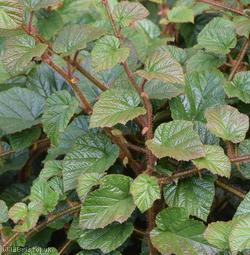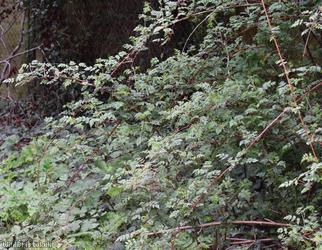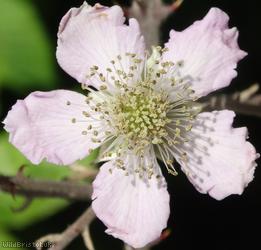Bramble - Rubus
Group Description
Common and widespread throughout the UK with over 400 'micro species' described in Britain; however many more are un-named and more are to be discovered. The bramble flora of the British Isles could well top 1000!
Growing habit:
Brambles are Deciduous Perennials which produce strong branches from the base in the first year known as primo canes. Fruit is produced on second year growth from these. Brambles are one of the fastest growing plants in the UK if not the fastest; growing at a rate of 3 inches (7.62 cm) a day at their peak. Flowers appear generally between May and September (but personally I've seen them as early as March and as late as the following new year) and fruit ripens from around July to October (the earliest I've ever eaten a blackberry was on the 7th June 2017). Seeds can remain viable for over 100 years! The fruit is made up of many little berry's called drupelets, each with one seed in surrounding a core called a torus.
Life story:
Brambles can produce seeds without pollination by the act of their own pollen falling on their own stigmas, not fertilising but stimulating the formation of fruit (apomixis). The offspring being clones - exact replicas of the parent plants.
They can also reproduce sexually though Rubus ulmifolius is the only diploid and the only fully sexual species of Subgenus Rubus. Hybridisation in Brambles is frequent. Often the offspring produced are infertile (little or no fruit is set) but on the occasions that fruit is formed; essentially a new species is created and fixed. The new species then spreads and repeats the procedure via apomixis or through pollination by others of the same kind. Any combination of Brambles crossing is possible which is why there are so many and why new species are constantly being produced.
Another method of reproduction is vegetatively - via runners - specialised branches which trail along the ground and root at each leaf node to produce many new plants of itself. Any branch that droops and touches the ground also has the ability to change from a shooting tip to a root stock.
Habitats:
Brambles have evolved to be associated with a wide range of habitats and conditions including: woodland, hedgerows, wetlands, heaths, coasts, open areas etc. Most species prefer acidic soils and in more calcareous districts often the only species to be found are Rubus ulmifolius and R. caesius.
Other names include:
Blackberry, Bramberry, Brambleberry, Brummel, European Blackberry, Black Heg, Wild Blackberry.
Useful Links:
Babington, C.C., 1869. The British Rubi
SubGroups
| name | latinname | species | sightings | media | image |
|---|---|---|---|---|---|
| Dalibardastrum | Dalibardastrum | 1 | 3 | 12 |  |
| Idaeobatus | Idaeobatus | 3 | 10 | 74 |  |
| Rubus | Rubus | 111 | 357 | 3107 |  |